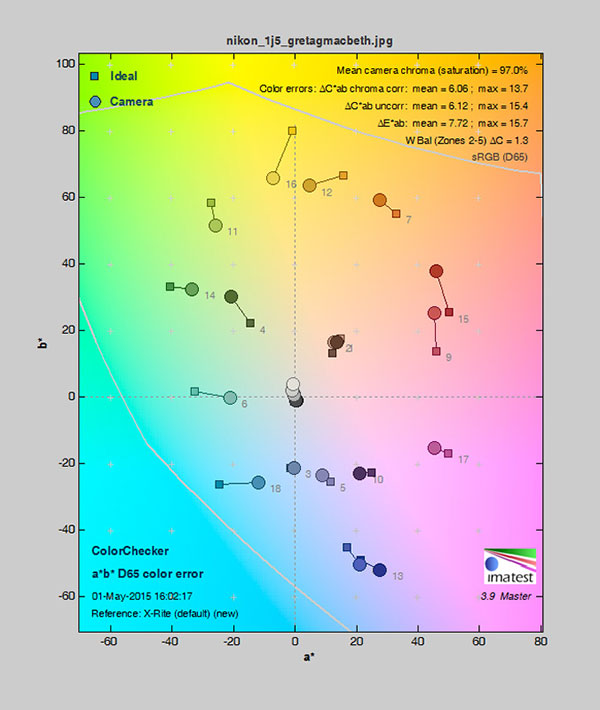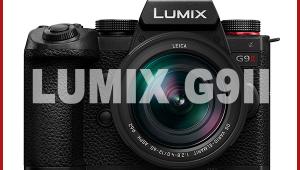Nikon 1 J5 Mirrorless Camera Review





Editor's Note: Lab test and comments are by Betternet, Shutterbug’s TIPA-affiliated testing lab. TIPA (www.tipa.com) is a worldwide association of photo and imaging magazine editors. Shutterbug is the sole US member of the association, and Editor at Large George Schaub serves as a member of the Technical Committee. You can find more Shutterbug photo gear reviews here.]
The Nikon J5 is the newest in Nikon's 1 series mirrorless camera line and is the first to offer 20MP resolution. (Note: the first Nikon 1 cameras had 10MP, while the most recent, the V3, had 18MP resolution). Compared to APS-C sensors with about 23.5 x 15.6 mm and Micro-Four-Third cameras with 17 x 13 mm, the Nikon J5 has a smaller sensor at 13.2 x 8.8 mm, Nikon’s CX format. The crop factor is nearly 1:2.7 which means that the “effective” (defined as the 35mm format equivalent) focal length of the kit lens (1 Nikkor 10-30mm f/3.5-5.6 VR) is about 27-81 mm. The Nikon J5 mirrorless camera has a very slim and compact design, which allows for easy transport and usage, similar to a compact camera.
The Nikon J5’s swivel LCD can be tilted downwards by nearly 90 degrees and upwards to nearly 180 degrees, increasingly known as the selfie position. The LCD is touch sensitive and can be used to set up the focus area and other parameters.
The Nikon J5 mirrorless camera has two setup dials. The first is located on the top and encircles the record button, which starts video recording. The right hand thumb can easily reach this dial. The dial can also be used for image parameter setup or for the magnifier function in review mode. The second setup dial is located on the back and encircles the cursor field to the right of the LCD screen. It is also used to set up image parameters.
The Nikon J5 mirrorless camera has a built-in flash system, but an accessory shoe for external flashes or for an additional electronic viewfinder is missing. The built-in flash system is helpful when shooting portraits in backlight situations or when taking indoor photos and offers a range of about 9-12 ft.
The Nikon J5 can take Full HD videos with up to 60 frames per second. In addition, the J5 offers a 4K video mode, but only at 15 frames per second, which for us isn't high enough for smooth video playback on the TV or PC screen.
The J5 has a hybrid focus system with 171 AF areas, including 105 phase detection sensors directly on the sensor. Combined with the kit lens, the J5 showed a very good AF performance, although we feel it isn’t as fast as other CSC cameras from Sony, Panasonic and Olympus.

Comments on Image Quality:
Color: The automatic white balance system of the Nikon 1 J5 caused a slight shift of neutral gray colors into the yellowish and greenish areas on our test chart. This effect relates directly to brightness: the brighter gray nuances are shifted more than darker areas. The color saturation of the test chart is nearly perfect. The Nikon reproduced it with 97.0 percent mean saturation, which in our opinion is a bit low for public taste. The skin tone reproduction is perfect. The differentiation of all colors is good. The threaded spools in our test shot show a lot of details, with only the red spool reproduced with a slightly “muddy” look.
Sharpness: The camera showed an excellent performance in our resolution tests. The ISO 12233 chart was reproduced with 3616 of 3713 lines per picture height, thus the camera converted nearly the nominal sensor resolution in real image details. The camera’s image processor enhances sharpness: we noted that hard contrast lines displayed some “over sharpening” effects such as double contours or halos. These effects are also noticeable in our portrait shot. The sharpness of the eye ashes of our model is a bit exaggerated. Combined with its kit lens, the camera showed some chromatic aberration effects on hard contrast lines. The Siemens star in the upper left of the test box shot shows magenta and green colored halos as this effect generally becomes visible in the corners of an image.

Noise: Even with the small sensor and its high pixel density (20MP on a CX sensor) the images of the Nikon 1 J5 are crisp and clear, even when they were taken with higher ISO speed settings. Up to ISO 6400 the luminance noise level keeps below 1.0 percent (in lower ISO speed settings between 0.5 and 0.8 percent), which is remarkably low. Color noise becomes visible in images taken at ISO 800, but is still negligible. In images taken at ISO 1600 and higher the anti-noise filtering becomes visible due to smoothing effects on contrast lines, but these filtering effects are acceptable even in the ISO 3200 to 6400 range. They get a little bothersome at the highest speed setting of ISO 12,800.
The dynamic range results are very good for a compact camera. The Nikon 1 J5 achieved a maximum of 11.5 f-stops at ISO 160 and keeps up a high level of about 10 to 11 f-stops up to ISO 800. At higher ISO settings the dynamic range results drops drastically, but is still acceptable (8-9 f-stops).

Pro:
+ ultra-compact system camera
+ high speed shooting with extreme burst rates and shutter speed settings up to 1/16000 sec
+ Wi-Fi and NFC system
Con:
- missing viewfinder (electronic or optical)
- 4K video mode with only 15 frames per second
The Nikon 1 J5 mirrorless camera sells for $499. More info at Nikon USA.
- Log in or register to post comments

















































